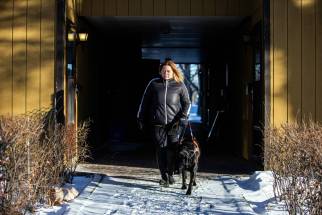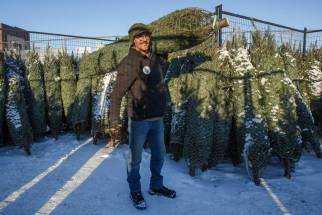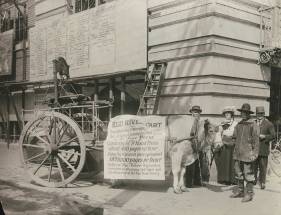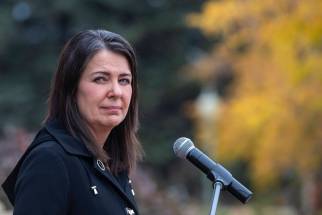Christmas trees — like everything else — are more expensive Fewer tree farms, inflation, labour shortages, climate change all contribute to prices that are 10 to 20 per cent higher than last year
Read this article for free:
or
Already have an account? Log in here »
To continue reading, please subscribe:
Monthly Digital Subscription
$0 for the first 4 weeks*
- Enjoy unlimited reading on winnipegfreepress.com
- Read the E-Edition, our digital replica newspaper
- Access News Break, our award-winning app
- Play interactive puzzles
*No charge for 4 weeks then price increases to the regular rate of $19.00 plus GST every four weeks. Offer available to new and qualified returning subscribers only. Cancel any time.
Monthly Digital Subscription
$4.75/week*
- Enjoy unlimited reading on winnipegfreepress.com
- Read the E-Edition, our digital replica newspaper
- Access News Break, our award-winning app
- Play interactive puzzles
*Billed as $19 plus GST every four weeks. Cancel any time.
To continue reading, please subscribe:
Add Free Press access to your Brandon Sun subscription for only an additional
$1 for the first 4 weeks*
*Your next subscription payment will increase by $1.00 and you will be charged $16.99 plus GST for four weeks. After four weeks, your payment will increase to $23.99 plus GST every four weeks.
Read unlimited articles for free today:
or
Already have an account? Log in here »
Hey there, time traveller!
This article was published 30/11/2022 (1104 days ago), so information in it may no longer be current.
Supply chain issues have taken root in the Christmas tree sector, with fewer farms producing smaller trees boasting higher prices.
Christmas tree stock has been declining for four or five years now. A tree takes about a decade to reach maturity, and the closure of tree farms in Canada during the Great Recession in 2008-09 — and the resultant lack of plants ready to go 10 or 12 years later — is now being felt.
Manitoba tree farmer Mike Kisiloski’s wishes for the perfect white spruce Christmas tree.
“I can’t get them to grow high enough,” Kisiloski said. “Everyone cuts them out way before I’m really satisfied that that’s a real nice tree.”
He’s one of the few Christmas tree farmers left in Manitoba. There’s 35 such farms, according to last year’s Statistics Canada data.
MIKAELA MACKENZIE / FREE PRESS FILES "It seems like the people are accepting (the prices), because they realize that everything has gone through the roof," said Mike Kisiloski, who runs Country Pines Tree Farm with his family.
In 2011, there were 60.
“It’s stupid,” Kisiloski said. “We used to have an association.”
He used to sell trees for $18, back in 2002. Now, a white spruce goes for $80 at Country Pines Tree Farm, if you’re chopping it yourself. Pre-cuts cost $100.
“It seems like the people are accepting (the prices), because they realize that everything has gone through the roof,” Kisiloski said.
He’s charging $20 more per tree than last year. Fuel, fertilizer and weed control costs have, in some cases, more than doubled — there’s no way to continue business without increasing prices, Kisiloski said.
He’s expecting to sell out after “a couple of days,” just like in years past.
MIKAELA MACKENZIE / FREE PRESS FILES Fuel, fertilizer and weed control costs have, in some cases, more than doubled — there’s no way to continue business without increasing prices, Kisiloski said.
“Nobody wanted to really take over the farms anymore,” Kisiloski said. “It puts a lot of pressure on me.”
Name your reason — higher input costs, labour shortages, farm kids changing careers and climate change. Whatever the case, the result has been a steady decline in Christmas trees being produced in Manitoba, Kisiloski said.
It’s a national thing, according to Shirley Brennan, executive director of the Canadian Christmas Trees Association.
“If I put a tree in the ground today, I don’t get paid for that tree for at least 10 years,” Brennan said. “It becomes a labour of love.”
Over the last decade, Canada has lost 20,000 acres of Christmas tree farms, amounting to 30 million trees not grown and sold, Brennan said.
The prairie provinces and Newfoundland split 3,000 of those lost acres.
“If I put a tree in the ground today, I don’t get paid for that tree for at least 10 years. It becomes a labour of love.”–Shirley Brennan
“There’s not a lot of Christmas tree farms in Manitoba,” Brennan noted.
Manitoba has 366 acres of Christmas tree farms, according to 2021 Statistics Canada data.
Some farmers left during the Great Recession of 2008-09. Climate change has affected the crops of many still in business, Brennan said.
Meantime, demand has jumped. In 2017, Manitoba’s Christmas tree industry garnered around $464,000. Last year, it was worth more than $750,000.
Jason Gauthier couldn’t get his usual supply of pre-cut trees from Ontario this year. He still has about 800 Christmas trees for people to chop at Windrift Christmas Tree Farm. However, it’s less than the 1,400 trees he usually sells annually.
“There’s just not trees available out there,” Gauthier said.
MIKE DEAL / WINNIPEG FREE PRESS “I find every year, we’re asked to order trees earlier and earlier,” Sean Strachan said.
Sean Strachan ordered roughly 500 trees in July.
“I find every year, we’re asked to order trees earlier and earlier,” Strachan said.
Years ago, September was the month to deal with suppliers of the Winnipeg Y Service Club’s tree lot, he said.
The price per tree has increased annually. It’s steeper this year, alongside higher fuel and operational costs, Strachan noted.
“We definitely are not projected to make as much money this year to give back,” he said.
Revenue from the Christmas trees sold outside the Elmwood-Kildonan YMCA-YWCA goes to scholarships and charity, and operational costs.
MIKE DEAL / WINNIPEG FREE PRESS The tree supply is roughly 12 per cent more expensive this year than last, Strachan said.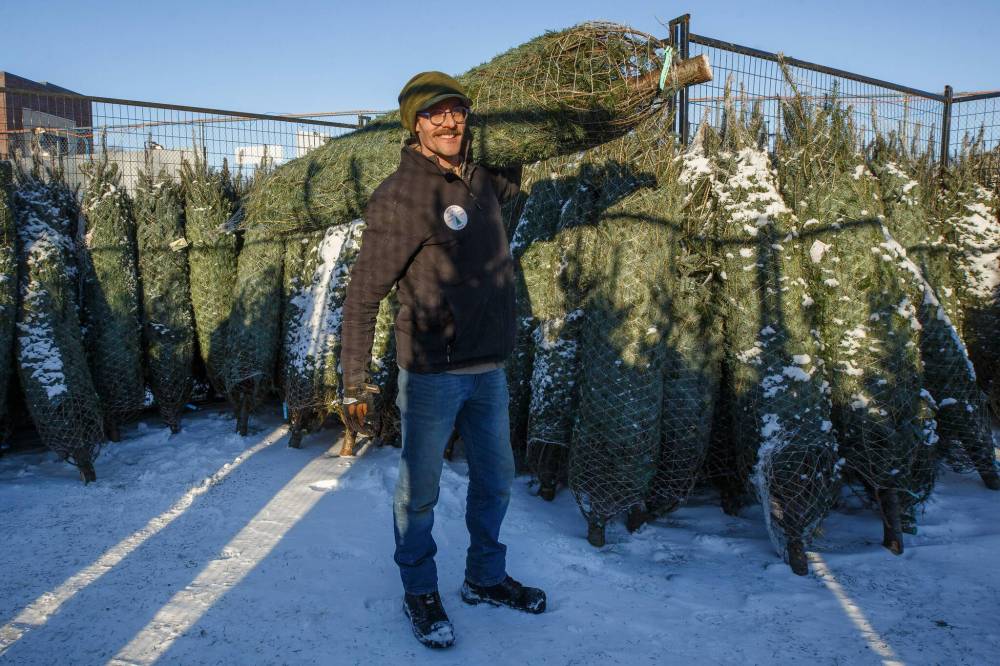
Last year, the group gave around $5,000 to the Christmas Cheer Board, Manitoba Harvest and nearby high schools, Strachan said.
“We hope that we can give the same (this year),” he said, adding he expects a 25 per cent drop in profit this season.
The tree supply is roughly 12 per cent more expensive this year than last, Strachan said. The group is charging $5 more per tree — a total $85 — which is less than needed to cover the price uptick.
“It’s expensive out there for everything, and Christmas is a tough time of year,” Strachan noted, adding it’s why he hasn’t raised prices further. “It’s been a hard time for a lot of people.”
Ron Paul’s Garden Centre is another to swallow costs, according to Ray DuBois, the St. Mary’s Rd. shop owner.
“If you have any concerns (with getting a tree), get it early and throw it in your backyard until you’re ready to put it up.”–Ray Dubois
“There was no way I could pass that,” he said, adding the store paid an extra 15 to 20 per cent on its trees.
Ron Paul’s has increased the prices on its 1,000 Christmas trees by roughly three per cent, Dubois said.
Trees are available, he noted. He anticipates selling out the week of Dec. 12 — a bit later than prior seasons. Heightened living costs may be contributing to slower sales this year, but it’s hard to tell, Dubois said.
“If you have any concerns (with getting a tree), get it early and throw it in your backyard until you’re ready to put it up,” he added.
Christmas tree prices are up 10 per cent nationally, according to Brennan from the Canadian Christmas Trees Association.
It takes 10 years for a tree to reach maturity, meaning the national shortage won’t end soon, she added.
— With files from Rachel Ferstl
gabrielle.piche@winnipegfreepress.com

Gabby is a big fan of people, writing and learning. She graduated from Red River College’s Creative Communications program in the spring of 2020.
Our newsroom depends on a growing audience of readers to power our journalism. If you are not a paid reader, please consider becoming a subscriber.
Our newsroom depends on its audience of readers to power our journalism. Thank you for your support.


